Apiaceae
Also known as the Carrot, Parsley or Umbel family.
Mostly herbs.
- Flowers usually perfect or perfect and male on the same plant, radially symmetrical (usually). Sepals 5, usually small and sometimes absent. Petals 5, not fused. Pistil compound, ovary inferior, carpels 2. Inflorescence an umbel
- Fruit a schizocarp.
- Leaves usually compound, alternate, without stipules, but usually the petiole has a sheathing base.
- About 300 genera and 3000 species, mainly in north temperate regions.
The Apiaceae is the 13th largest family in B.C., with 61 taxa occurring in the province. The family is easily recognized by its usually compound leaves, umbellate inflorescence, 5-merous flowers with an inferior ovary, and distinctive fruit, but genera and species are often difficult to identify. Many keys require mature fruits for definite identification. The plants and especially fruits often contain aromatic oils, which are used as flavorings. Many species are edible, but some are deadly poisonous, including the poison hemlock with which Socrates was executed.
Cultivated crops include Apium (celery, celeriac), Pastinaca (parsnip), Daucus (carrot), Foeniculum (fennel), Anethum (dill), Cuminum (cumin), Pimpinella (anise), Petroselinum (parsely), Carum (caraway), and Coriandrum (coriander, Chinese parsley, or cilantro).
Leaves
| Angelica archangelica – the root of this plant is used medicinally. |
 Angelica archangelica plant |
| You can see the dilated, sheathing petiole which is characteristic of most plants in this family. |
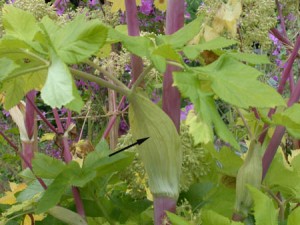 Angelica archangelica, With Sheathing Petiole |
| Foeniculum vulgare (Fennel). Fennel can grow quite large. This picture was taken in the medicinal plant garden in the UBC Botanical Garden. |
 Fennel Plant |
| Upon closer inspection of the picture you can see the alternate arrangement of the leaves. |
 Fennel Plant, With Alternating Leaves |
Inflorescence
The inflorescence of this family is an umbel. Umbels are a flat-topped inflorescence with all of the flower stalks arising from a common point (like the spokes of an umbrella).
| Heracleum (Cow Parsnip) |
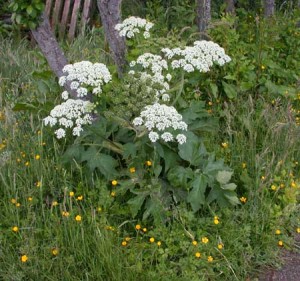 Cow Parsnip |
| This is a typical type of inflorescence of members of this family….an umbel. It is a compound umbel. |
 Example of a Compound Umbel. |
| Here is a look at the flowers. |
 Flowers of the Cow Parsnip |
| Foeniculum vulgare (fennel). – a good example of a flower which has a stylopodium. |
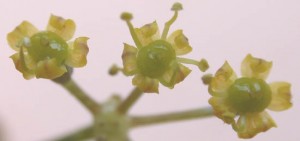 Foeniculum vulgare flowers |
| The side view shows the stylopodium the best (indicated with an arrow). |
 Close up of Fennel Flowers |
| Eryngium (coyote thistle) – this is an example of a member of the Apiaceae which has a very dense head (the umbellets are sessile). |
 Coyote Thistle Plant |
| Here is a head with young flowers. |
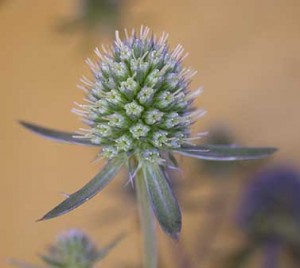 Coyote Thistle, Head With Young Flowers |
| Here the flowers (umbellets) are blooming. |
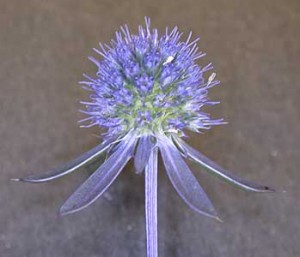 Umbellets |
Fruits
The fruits of this family are called schizocarps. Schizocarps are fruits from an ovary made up of more than one fused caprels that splits into its separate but indehiscent carpels at maturity
| Here is a picture of some immature schizocarps of cow parsnip (Heracleum): |
 Fruits of the Cow Parsnip |
| This cross-section demonstrates that the ovary is made up of two carpels. The arrow indicates an oil canal. |
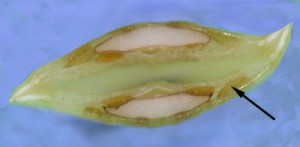 Longitudinal Section of Cow Parsnip Fruit |
| Here is a side view of the schizocarp. You can see the two flat mericarps (one-seeded indehiscent carpels). This fruit is compressed dorsally. |
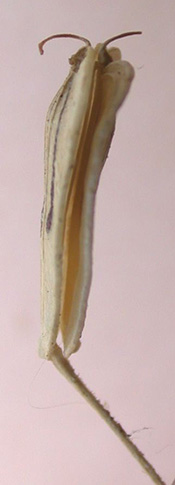 Schizocarp, Side View |
| This is the face-view of a schizocarp. |
 Schizocarp, Face View |
| You can see the oil canals (indicated with an “o”) and the nerves (veins, indicated with an “N”). |
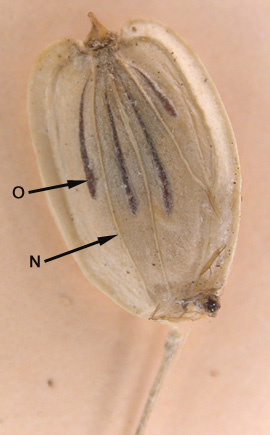 Schizocarp, Face View, Illustrating Oil Canals |
| The y-shaped carpophore can be seen holding up the mericarps. |
 Fruits of the Cow Parsnip |
| This is an example of laterally compressed schizocarp: |
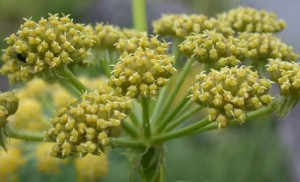 Laterally Compressed Schizocarps |
| Another view. |
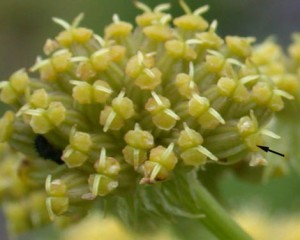 Laterally Compressed Shizocarps, Close Up |
Other Members of the Apiaceae Family
| Astrantia (Hattie’s pincushion, Masterwort) |
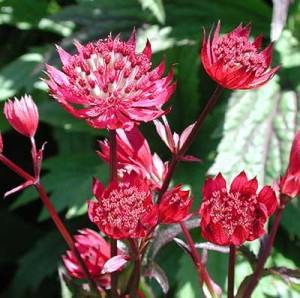 Astrantia |
| Close Up. |
 Astrantia |
| Daucus carota (carrot). Here is what carrot plants looks like. You may notice that if you grow carrots that in the first year you will not see any flowers. That is because they are biennials. It takes two years to complete the lifecycle. In the first year energy is stored in the root…hence the big root. In the second year this energy is used to generate the flowers and fruit. |
 Carrot Plants |
| The carrot itself is a big storage root. |
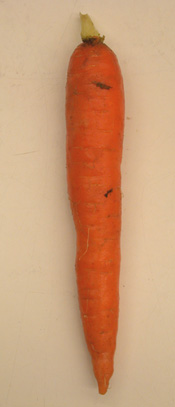 |
| Fruits are schizocarps. |
 Schizocarp |
| Close up of a schizocarp. |
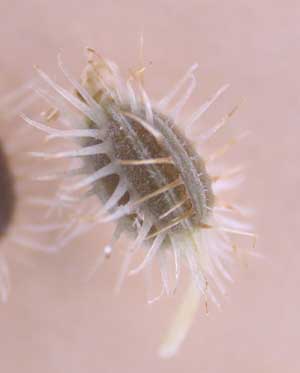 Schizocarp |
| Petroselinum (Parsley). |
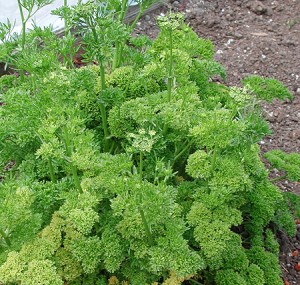 Parsley Plant |
| Flowers of parsley. |
 Parsley Flowers |
| Glehnia littoralis (beach carrot). This plant is is found on sand dunes and beaches along the coast from Alaska to northern California. It has a very short stem. |
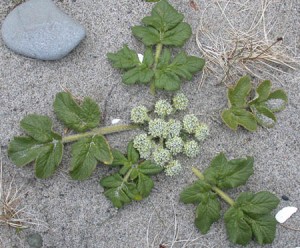 Beach Carrot |
| Here you can see umbels that are flowering and one which is past flowering. |
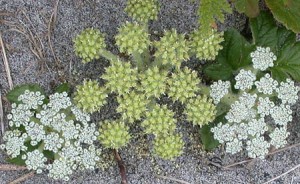 Inflorescence, Some Past Flowering |
| Here are some flowers: |
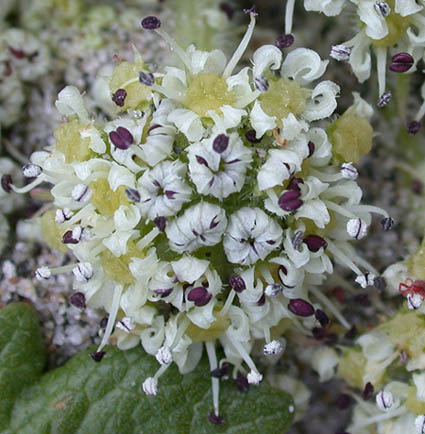 Flowers of the beach carrot |
| Fruits of this plant have a very short fall to the ground. |
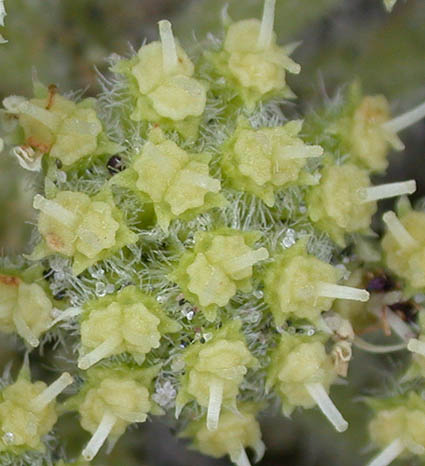 Fruits of the Beach Carrot |
| The roots of beach carrot are used in Chinese herbal preparatins to clear lungs and to imporve digestion. |
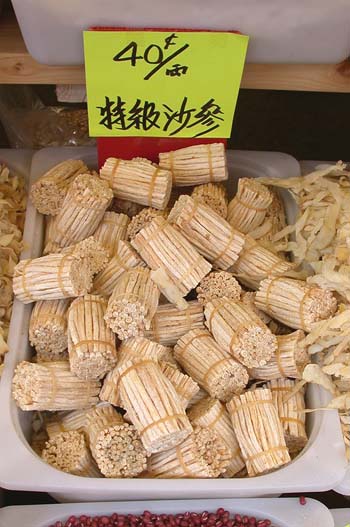 Roots, Sold for Digestion Aid |
| Oenanthe sarmentosa (Water-parsley): This plant grows in wet areas. You can find it aloong the trail along Beaver Lake in Stanley Park. |
 Water Parsley |
Back to Lab 4

































